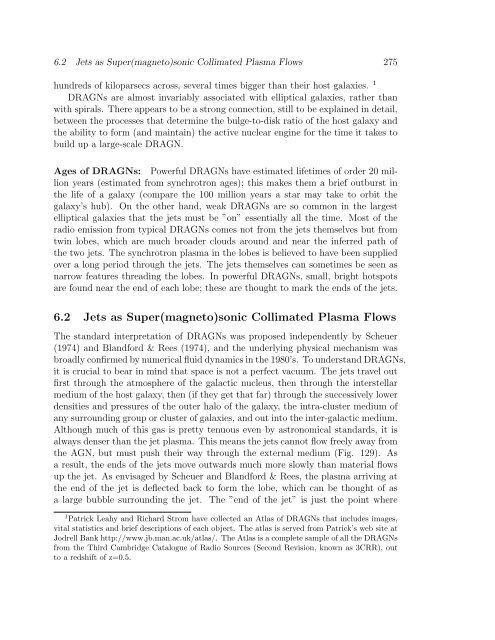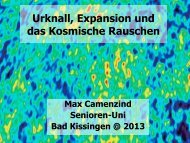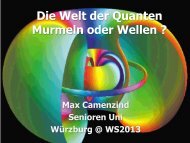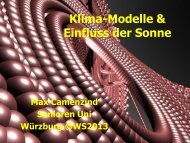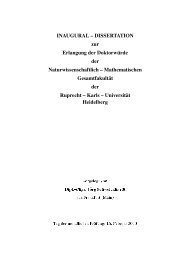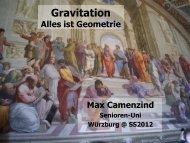Contents List of Figures
Contents List of Figures
Contents List of Figures
Create successful ePaper yourself
Turn your PDF publications into a flip-book with our unique Google optimized e-Paper software.
6.2 Jets as Super(magneto)sonic Collimated Plasma Flows 275<br />
hundreds <strong>of</strong> kiloparsecs across, several times bigger than their host galaxies. 1<br />
DRAGNs are almost invariably associated with elliptical galaxies, rather than<br />
with spirals. There appears to be a strong connection, still to be explained in detail,<br />
between the processes that determine the bulge-to-disk ratio <strong>of</strong> the host galaxy and<br />
the ability to form (and maintain) the active nuclear engine for the time it takes to<br />
build up a large-scale DRAGN.<br />
Ages <strong>of</strong> DRAGNs: Powerful DRAGNs have estimated lifetimes <strong>of</strong> order 20 million<br />
years (estimated from synchrotron ages); this makes them a brief outburst in<br />
the life <strong>of</strong> a galaxy (compare the 100 million years a star may take to orbit the<br />
galaxy’s hub). On the other hand, weak DRAGNs are so common in the largest<br />
elliptical galaxies that the jets must be ”on” essentially all the time. Most <strong>of</strong> the<br />
radio emission from typical DRAGNs comes not from the jets themselves but from<br />
twin lobes, which are much broader clouds around and near the inferred path <strong>of</strong><br />
the two jets. The synchrotron plasma in the lobes is believed to have been supplied<br />
over a long period through the jets. The jets themselves can sometimes be seen as<br />
narrow features threading the lobes. In powerful DRAGNs, small, bright hotspots<br />
are found near the end <strong>of</strong> each lobe; these are thought to mark the ends <strong>of</strong> the jets.<br />
6.2 Jets as Super(magneto)sonic Collimated Plasma Flows<br />
The standard interpretation <strong>of</strong> DRAGNs was proposed independently by Scheuer<br />
(1974) and Blandford & Rees (1974), and the underlying physical mechanism was<br />
broadly confirmed by numerical fluid dynamics in the 1980’s. To understand DRAGNs,<br />
it is crucial to bear in mind that space is not a perfect vacuum. The jets travel out<br />
first through the atmosphere <strong>of</strong> the galactic nucleus, then through the interstellar<br />
medium <strong>of</strong> the host galaxy, then (if they get that far) through the successively lower<br />
densities and pressures <strong>of</strong> the outer halo <strong>of</strong> the galaxy, the intra-cluster medium <strong>of</strong><br />
any surrounding group or cluster <strong>of</strong> galaxies, and out into the inter-galactic medium.<br />
Although much <strong>of</strong> this gas is pretty tenuous even by astronomical standards, it is<br />
always denser than the jet plasma. This means the jets cannot flow freely away from<br />
the AGN, but must push their way through the external medium (Fig. 129). As<br />
a result, the ends <strong>of</strong> the jets move outwards much more slowly than material flows<br />
up the jet. As envisaged by Scheuer and Blandford & Rees, the plasma arriving at<br />
the end <strong>of</strong> the jet is deflected back to form the lobe, which can be thought <strong>of</strong> as<br />
a large bubble surrounding the jet. The ”end <strong>of</strong> the jet” is just the point where<br />
1 Patrick Leahy and Richard Strom have collected an Atlas <strong>of</strong> DRAGNs that includes images,<br />
vital statistics and brief descriptions <strong>of</strong> each object. The atlas is served from Patrick’s web site at<br />
Jodrell Bank http://www.jb.man.ac.uk/atlas/. The Atlas is a complete sample <strong>of</strong> all the DRAGNs<br />
from the Third Cambridge Catalogue <strong>of</strong> Radio Sources (Second Revision, known as 3CRR), out<br />
to a redshift <strong>of</strong> z=0.5.


